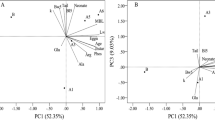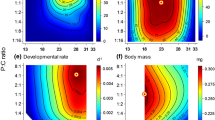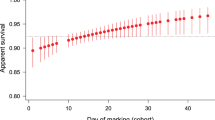Abstract
Senescence is a general decline of physiological state that accompanies advancing age. It affects nearly all organisms, but patterns of senescence vary markedly, even among closely related taxa. Understanding the evolution of this diversity requires information about environmental effects on the expression of variation among taxa. I examined genetically-based variation of senescence within and between two species complexes of Daphnia in four environments. The environments were defined by large differences in food and temperature, two factors known to influence senescence. The species studied were chosen to represent sister species that likely experience divergent (D. pulex and D. pulicaria) or similar (D. mendotate and D. dentifera) selection pressures on senescence. Overall, D. pulex expressed the greatest demographic senescence, D. mendotae and D. dentifera were intermediate, and D. pulicaria expressed the least. In environments representative of typical natural conditions, D. pulex had greater senescence than D. pulicaria, regardless of how late-life performance was assessed. This shows that genetic-environment interactions do not confound the interpretation of senescence differences between these species as the result of selective differences between their habitats. Comparison of D. mendotae and D. dentifera primarily revealed similar life histories, although differences in reproductive declines occurred in some environments. The joint observation of similar mortality patterns but dissimilar fecundity declines suggests that the trade-off between survival and reproduction changes with age. This calls into question the utility of only studying mortality for understanding evolutionary change of senescence in nature.






Similar content being viewed by others
References
Abrams PA (1993) Does increased mortality favor the evolution of more rapid senescence? Evolution 47:877–887
Austad SN (1993a) The comparative perspective and choice of animal models in aging research. Aging Clin Exp Res 5:259–267
Austad SN (1993b) Retarded senescence in an insular population of Virginia Opossums (Didelphis virginiana). J Zool 229:695–708
Beverton RA (1987) Longevity in fish: some ecological and evolutionary considerations. In: Woodhead AD, Thompson KH (eds) Evolution of longevity in animals. Plenum, New York
Chapman T, Partridge L (1996) Female fitness in Drosophila melanogaster: an interaction between the effect of nutrition and of encounter rate with males. Proc R Soc Lond Ser B 263:755–759
Colbourne JK, Hebert PDN (1996) The systematics of North American Daphnia (Crustacea: Anomopoda): a molecular phylogenetic approach. Phil Trans R Soc Lond Ser B 351:349–360
Comfort A (1979) The biology of senescence. Elsevier, New York
Crease TJ, Lee S-K, Yu S-L, Spitze K, Lehman N, Lynch M (1997) Allozyme and mtDNA variation in populations of the D. pulex complex from both sides of the Rocky Mountains. Heredity 79:242–251
Deng H-W (1997) Photoperiodic response of sexual reproduction in the Daphnia pulex group is reversed in two distinct habitats. Limnol Oceanogr 42:609–611
Desmarais KH (1997) Keeping Daphnia out of the surface film with cetyl alcohol. J Plankton Res 19:149–154
Dodson SI (1972) Mortality in a population of Daphnia rosea. Ecology 53:1011–1023
Dudycha JL (1999) The evolutionary ecology of senescence in Daphnia. Ph.D. dissertation. Michigan State University, Michigan
Dudycha JL (2001) The senescence of Daphnia from risky and safe habitats. Ecol Lett 4:102–105
Dudycha JL, Tessier AJ (1999) Natural genetic variation of life span, reproduction and juvenile growth in Daphnia. Evolution 53:1744–1756
Edney EG, Gill RW (1968) Evolution of senescence and specific longevity. Nature 220:281–82
Finch CE (1990) Longevity, senescence and the genome. University of Chicago Press, Chicago
Fry JD (1992) The mixed-model analysis of variance applied to quantitative genetics: biological meaning of the parameters. Evolution 46:540–550
Geedey CK (1997) Seasonal clonal succession in Daphnia pulicaria populations. Dissertation, Michigan State University
Geedey CK, Tessier AJ, Machledt K (1996) Habitat heterogeneity, environmental change, and the clonal structure of Daphnia populations. Funct Ecol 10:613–621
Hall DJ (1964) An experimental approach to the dynamics of a natural population of Daphnia galeata mendotae. Ecology 45:94-112
Hamilton WD (1966) The moulding of senescence by natural selection. J Theor Biol 12:12–45
Hebert PDN (1995) The Daphnia of North America: an illustrated fauna, version 1. CD-ROM. The University of Guelph, Guelph, Ontario
Hu SS, Tessier AJ (1995) Seasonal succession and the strength of intra- and interspecific competition in a Daphnia assemblage. Ecology 76:2278–2294
Ingle L (1933) Effects of environmental conditions on longevity. Science 78:511
Ingle L, Wood TR, Banta AM (1937) A study of longevity, growth, reproduction and heart rate in Daphnia longispina as influenced by limitations in quantity of food. J Exp Zool 76:325–52
Keller L, Genoud M (1997) Extraordinary lifespans in ants: a test of evolutionary theories of ageing. Nature 389:958–960
Kirk KL (1997) Life-history responses to variable environments: starvation and reproduction in planktonic rotifers. Ecology 78:434–441
Knoechel R, Holtby LB (1986) Construction and validation of a body-length based model for the prediction of cladoceran community filtering rates. Limnol Oceanogr 31:1–16
Korpelainen H (1986) The effects of temperature and photoperiod on life history parameters of Daphnia magna (Crustacea: Cladocera). Freshw Biol 16:615–620
Lehman, Pfrender NME, Morin PA, Crease TJ, Lynch M (1995) A hierarchical molecular phylogeny within the genus Daphnia. Mol Phylogenet Evol 4:395–407
Leibold MA, Tessier AJ (1991) Contrasting patterns of body size for Daphnia species that segregate by habitat. Oecologia 86:342–348
Leibold MA, Tessier AJ (1998) Experimental compromise and mechanistic approaches to the evolutionary ecology of interacting Daphnia species. In: Resetarits WJ Jr, Bernardo J (eds) Experimental ecology. Oxford University Press, New York
Lynch M (1984) The limits to life history evolution in Daphnia. Evolution 38:465–82
MacArthur JW, Baillie WHT (1929) Metabolic activity and the duration of life. I. Influence of temperature on longevity in Daphnia magna. J Exp Zool 53:221–242
McDonald DB, Fitzpatrick JW, Woolfenden GE (1997) Actuarial senescence and demographic heterogeneity in the Florida Scrub Jay. Ecology 77:2373–2381
Medawar PB (1952) An unsolved problem of biology. Lewis, London
Pletcher SD (1999a) Model fitting and hypothesis testing for age-specific mortality data. J Evol Biol 12:430–439
Pletcher SD (1999b) WinModest, v. 1.0.2. Max Planck Institute for Demography, Rostock
Promislow DEL (1991) Senescence in natural populations of mammals: a comparative study. Evolution 45:1869–1887
Promislow DEL, Tatar M, Pletcher S, Carey JR (1999) Below threshold mortality: implications for studies in evolution, ecology and demography. J Evol Biol 12:314–328
Reznick D (1993) New model systems for studying the evolutionary biology of aging: Crustacea. Genetica 91:79–88
Ricklefs RE (1998) Evolutionary theories of aging: Confirmation of a fundamental prediction, with implications for the genetic basis and evolution of life span. Am Nat 152:24–44
Rose MR (1991) Evolutionary biology of aging. Oxford University Press, New York
Shaw FH, Promislow DEL, Tatar M, Hughes KA, Geyer CJ (1999) Toward reconciling inferences concerning genetic variation in senescence in Drosophila melanogaster. Genetics 152:553–566
Tatar M, Carey JR (1995) Nutrition mediates reproductive trade-offs with age-specific mortality in the beetle Callosobruchus maculatus. Ecology 76:2066–2073
Tatar M, Gray DW, Carey JR (1997) Altitudinal variation for senescence in Melanoplus grasshoppers. Oecologia 111:357–364
Taylor DJ, Hebert PDN (1992) Daphnia galeata mendotae as a cryptic species complex with interspecific hybrids. Limnol Oceanogr 37:658–665
Taylor DJ, Hebert PDN, Colbourne JK (1996) Phylogenetics and evolution of the Daphnia longispina group (Crustacea) based on 12S rDNA sequence and allozyme variation. Mol Phylogenet Evol 5:495–510
Tessier AJ, Consolatti N (1991) Resource quantity and offspring quality in Daphnia. Ecology 72:468–478
Tessier AJ, Woodruff P (2002a) Trading off the ability to exploit rich versus poor food quality. Ecol Lett 5:685–692
Tessier AJ, Woodruff P (2002b) Cryptic trophic cascade along a gradient of lake size. Ecology 83:1263–1270
Tessier AJ, Young A, Leibold M (1992) Population dynamics and body-size selection in Daphnia. Limnol Oceanogr 37:1–13
Threlkeld ST (1979) The midsummer dynamics of two Daphnia species in Wintergreen Lake, Michigan. Ecology 60:165–179
Threlkeld ST (1980) Habitat selection and population growth of two Cladocerans in seasonal environments. In: Kerfoot WC (ed) Evolution and ecology of zooplankton communities. University Press of New England, Hanover, N.H.
Williams GC (1957) Pleiotropy, natural selection and the evolution of senescence. Evolution 11:398–411
Acknowledgements
Alan J. Tessier offered thoughtful advice, encouragement and access to unpublished data. Pam Woodruff's assistance in the laboratory was invaluable and Art Dudycha helped with field collections. A. Tessier, J. Conner, B. Black, C. Cáceres, D. Reznick and an anonymous reviewer offered constructive comments on earlier drafts. The research was supported by a Lauff Research Award and NSF grants DEB-9421539 (to A.J.T.), research training grants DIR-9113598 and DBI-9602252 (to the Kellogg Biological Station), dissertation improvement grant DEB-9701209, and a pre-doctoral fellowship. This is KBS contribution number 989.
Author information
Authors and Affiliations
Corresponding author
Rights and permissions
About this article
Cite this article
Dudycha, J.L. A multi-environment comparison of senescence between sister species of Daphnia . Oecologia 135, 555–563 (2003). https://doi.org/10.1007/s00442-003-1230-7
Received:
Accepted:
Published:
Issue Date:
DOI: https://doi.org/10.1007/s00442-003-1230-7




